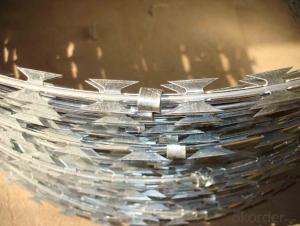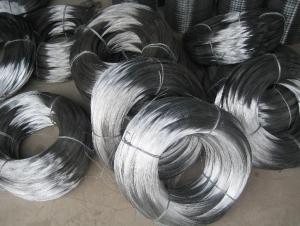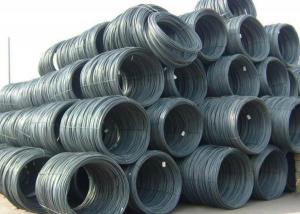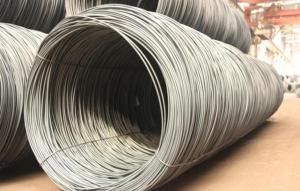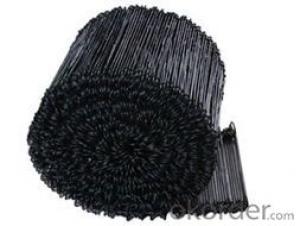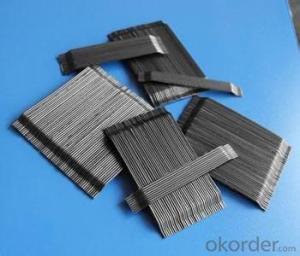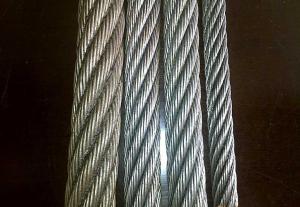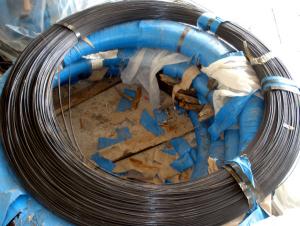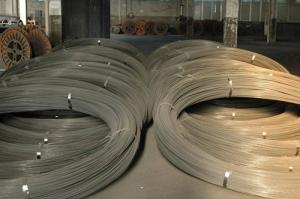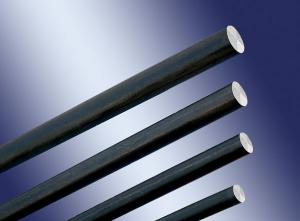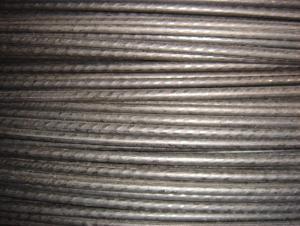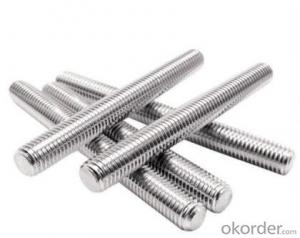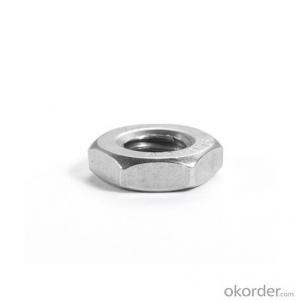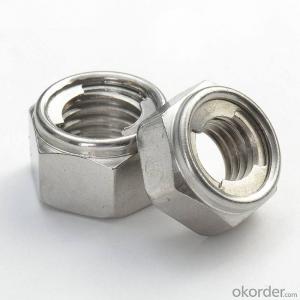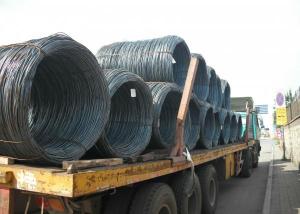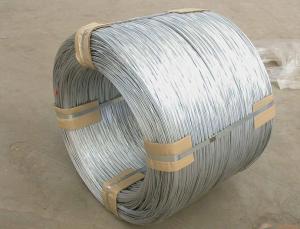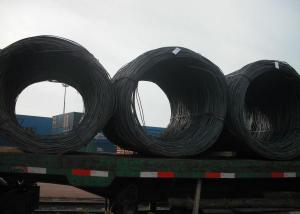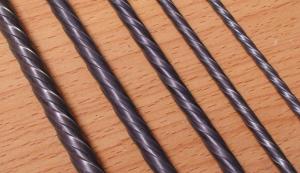Galvanized Concertina Razor Barbed Wire for Security Fence
- Loading Port:
- Tianjin
- Payment Terms:
- TT OR LC
- Min Order Qty:
- 5 m.t.
- Supply Capability:
- 5000 m.t./month
OKorder Service Pledge
OKorder Financial Service
You Might Also Like
Item specifice
Product Description
BTO-22 Hot dipped Galvanized Military Concertina Razor Wire
Razor wire is also named concertina wire, razor barbed wire, fencing wire, or razor type barbed wire. It is a kind of modern security fencing materials with better protection and fencing strength made of hot-dipped galvanized steel sheets or stainless steel sheets.
With beautiful and sharp blades and strong core wire, razor wire has the features of secure fencing, easy installation, age resistance and other properties
Galvanized concertina razor barbed wire 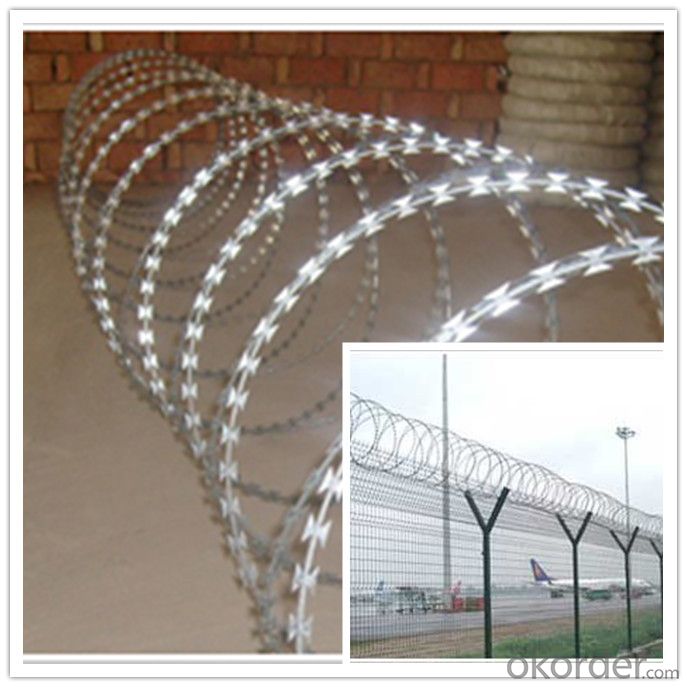
1.Razor wireintroduction
Razor wire is a kind of modern security fencing materials fabricated with razor-sharp steel blade and high-tensile wire.
2. Regular specifications of razor barbed wire:
Specification | Blade thickness | Wire diameter | Blade length | Blade width | Blade spacing |
BTO-10 | 0.5±0.05 | 2.5±0.1 | 10±1 | 13±1 | 26±1 |
BTO-12 | 0.5±0.05 | 2.5±0.1 | 12±1 | 15±1 | 26±1 |
BTO-18 | 0.5±0.05 | 2.5±0.1 | 18±1 | 15±1 | 33±1 |
BTO-22 | 0.5±0.05 | 2.5±0.1 | 22±1 | 15±1 | 34±1 |
BTO-28 | 0.5±0.05 | 2.5±0.1 | 28 | 15 | 45±1 |
BTO-30 | 0.5±0.05 | 2.5±0.1 | 30 | 18 | 45±1 |
CBT-60 | 0.6±0.05 | 2.5±0.1 | 60±2 | 32±1 | 100±2 |
CBT-65 | 0.6±0.05 | 2.5±0.1 | 65±2 | 21±1 | 100±2 |
3. Razor wire Popular specification:
Standard BTO-22
Crossed type
Blade thickness: 0.5mm
Wire diameter: 2.5mm
Blade length: 22mm
Blade width :15mm
Blade spacing: 34mm
Standard covering length 8m
Surface: hot dipped galvanized plate stamping
4. Application:
Razor wire is a new kiind of protection fence with such advantages as beautiful appearance, economical cost, practicality and convenient construction.
razor wire plays the roll of protection in mine,garden apartment,frontier post and prison.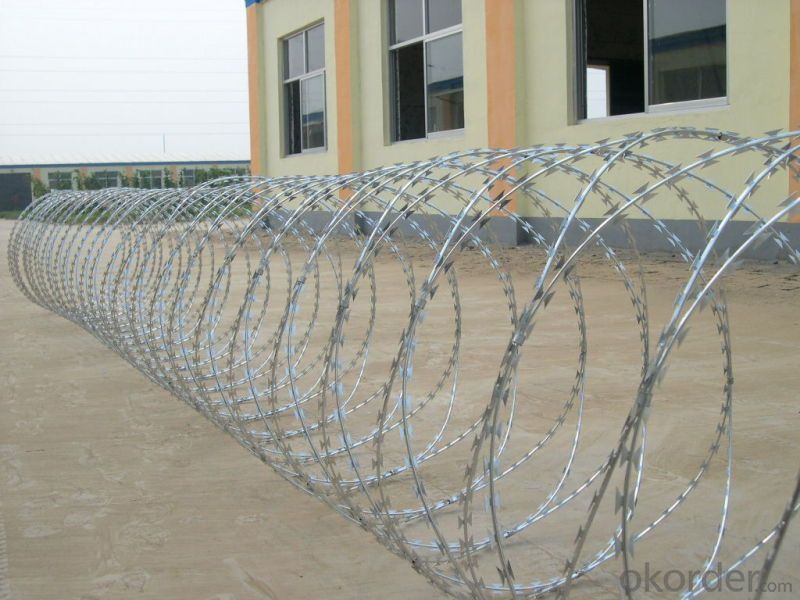
- Q:hello,i have lots of 8 gauge wire resting at my closet. And i'm very interested on doing the big 3 upgrade to my 2000 mitsubishi eclipse gt. May i see any improvement with 8 gauge wire?...i know that at least 4 gauge is recommended...but i dont want to spend money.
- Go cheap, get cheap. Improvement, maybe. But heres a secenario: current draw exceeds capacity of 8 gauge wire, insulation melts, positive wire grounds out, lots of smoke, fire.... no wait... FIRE! Oh s**t that's gonna cost me..... (a lot more than 4 gauge wire I'll bet...)
- Q:Hey can some1 help me, on my lamp i have a White, a Yellow wire with tints of green in it and a black wire. on my cord that i am going to plug in is a Blue, brown and a yellow wire
- US wiring uses black as hot, white as neutral, and green or yellow/green as ground. European (IEC) wiring uses brown as hot, blue as neutral and green/yellow as ground. Your connections would be black to brown, white to blue, and yellow/green to yellow. Don
- Q:What role does the neutral wire play?
- Commercial city electricity comes from the power plant in the form of three-phase current. Each phase requires one wire, and the neutral is the common return path for all three. It's more complicated than that, but that will get you started. Near your house there is a transformer that takes one leg of the three-phase power line and reduces it to the voltages used by your household lights and appliances. The neutral wire is grounded at the pole and at your house, and connected to the neutral line in the three-phase wiring, so that it provides a safety ground connection and a return path for electric current. IT IS VERY IMPORTANT that the neutral wire be connected correctly and properly maintained. Never let anyone fool with it unless you are sure they know what they are doing. A bad neutral can burn your house down, very quickly. It's much easier to explain city wiring and house wiring with diagrams and pictures. Try an internet search on house wiring. Good luck.
- Q:I have a 200 amp main breaker just below my meter, which is mounted on a pole. The neutral wire coming in is run to ground. From this box, I've run 2 cables (1/0) ~80 ft to another box with a 150 amp main breaker. This box is grounded to an 8ft ground rod. I am wondering whether this setup (no neutral wire from meter pole to building) would potentially allow a ground fault without tripping the 200 amp main. For example, if somebody dug into the line with a backhoe? Oh yeah, the cable is in a 3ft deep trench that will be covered. I have an abridged version of the NEC, but I haven't found this particular topic covered. Thanks.
- Good job, Amy. I'll bet you didn't post a question here similar to: Waz the difference between nuetral and ground. I nned to now this for my electian exam tomorow.
- Q:A long horizontal wire carries a current of = 52 . A second wire, made of 1.00--diameter copper wire and parallel to the first, is kept in suspension magnetically 5.0 below.What is the magnitude of the current in the lower wire?
- There is 1V across ampere meter. To find the current.... Current = 1V / meter internal resistance
- Q:I have a 2 wire system in my garage and need to update to a 3 wire grounded plug. Can I leave my existed 2 conductor and just run a single 12 gauge insulated ground in the same conduit back to the panel/grounding rod. Or do I need to pull out the 2 wore replace with 3 wire ?
- You can just add a wire. If you have metal conduit and metal j-boxes all you have to do is connect a ground to the box. NEC 250.118 Types of Equipment Grounding Conductors. The equipment grounding conductor run with or enclosing the circuit conductors shall be one or more or a combination of the following: (1) A copper, aluminum, or copper-clad aluminum conductor. This conductor shall be solid or stranded; insulated, covered, or bare; and in the form of a wire or a busbar of any shape. (2) Rigid metal conduit. (3) Intermediate metal conduit. (4) Electrical metallic tubing... But if not in metal conduit then you can connect it to the first 5 feet of metal water pipe, the ground rod, the wire leading to the ground rod/metal water pipe, or the ground bar in the source electrical panel. NEC 250.130(C) Nongrounding Receptacle Replacement or Branch Circuit Extensions. The equipment grounding conductor of a grounding-type receptacle or a branch-circuit extension shall be permitted to be connected to any of the following: (1) Any accessible point on the grounding electrode system as described in 250.50 (2) Any accessible point on the grounding electrode conductor (3) The equipment grounding terminal bar within the enclosure where the branch circuit for the receptacle or branch circuit originates (4) For grounded systems, the grounded service conductor within the service equipment enclosure
- Q:I have this ipod cord in my car to play music off of, and at first it started cutting out. I would move the wire in a specific spot to a position to where it would work. Then eventually it just stopped working all together, so im assuming the wires inside have been damaged. Now as i said before in a specific spot so im pretty positive i know where it is broken at, but ive never actually spliced a wire, or soldered before. This is where i need help. What tools and materials will i need to fix the wire? Also, how would i fix it? Thanks for the help in advance!
- The wires in those little patch cords and headphones and stuff are often very fine and hard to splice or solder. You could get you some wire cutters and wire strippers and a soldering iron and some electrical tape or shrink wrap and go at it, but it would probably be just as well to get another cord.
- Q:How much wire is required?
- Length of wire is L = R*A/p SI units must be used, so convert radius to meters: r = 0.0254 / 64 m using 25.4mm = 1 inch r = 3.969*10^-4 m (0.3969mm) So cross-sectional area is A = pi*(3.969*10^-4)^2 m^2 A = 4.95*10^-7 m^2 The average resistivity of nichrome is p = 1.1*10^-6 ohm-meter So the required length of wire is L = 2.2 ohm * 4.95*10^-7 m^2 / 1.1*10^-6 ohm-meter L = 0.990 m
- Q:I always see birds hang on the wires but never get fried how do they do. It?
- We won't get a shock if we fly or when we aren't grounded... Because, Current flows only in closed circuits . A bird sitting in the wire doesn't form a complete circuit in order for the current to flow. In other words, Birds have their feet in the same wire. I've seen many days, birds (like crows in our country) get shocks. Sometimes birds too touch the Phase and neutral (or Earthing) wires thereby creating a largest potential difference, get toasted fall down. Not all birds are clever.
- Q:I wired an outdoor lamp-post. I tested it before wiring it to the fuse box...and if I touch the lamp-post I feel the current (a slight shock). I will be using a ground fault breaker....so I assume if I wire it to that I am going to loose the connection. Any thoughts on what is wrong?
- You likely scratched the wire somewhere. When I did an outdoor shed the wire made a corner on some metal and scratched the insulation. It is a leak rather than hooking up the wrong wire, otherwise you would have gotten more than a tingle. First I would examine everywhere the wire comes in contact with the post. Second Check all the connections to see if some were improperly taped, or the wire was cut when stripping.
1. Manufacturer Overview |
|
|---|---|
| Location | |
| Year Established | |
| Annual Output Value | |
| Main Markets | |
| Company Certifications | |
2. Manufacturer Certificates |
|
|---|---|
| a) Certification Name | |
| Range | |
| Reference | |
| Validity Period | |
3. Manufacturer Capability |
|
|---|---|
| a)Trade Capacity | |
| Nearest Port | |
| Export Percentage | |
| No.of Employees in Trade Department | |
| Language Spoken: | |
| b)Factory Information | |
| Factory Size: | |
| No. of Production Lines | |
| Contract Manufacturing | |
| Product Price Range | |
Send your message to us
Galvanized Concertina Razor Barbed Wire for Security Fence
- Loading Port:
- Tianjin
- Payment Terms:
- TT OR LC
- Min Order Qty:
- 5 m.t.
- Supply Capability:
- 5000 m.t./month
OKorder Service Pledge
OKorder Financial Service
Similar products
New products
Hot products
